Tinykin is a 3D platformer about a lost explorer who must build a machine to take him home with the help of diminutive creatures called Tinykin. I play as Milodane, an archeologist on the planet Aegis who has a radical theory: Humans are not originally from Aegis! To prove his theory, Milodane tracks an alien signal to a distant galaxy and builds a teleportation device to send him there. The teleporter deposits him in a seemingly ordinary house where he stands no more than a few centimeters in height. To return home, Milodane visits all of the colossal house’s rooms, each colonized by different bug species. With the help of the Tinykin, rotund creatures with fantastic and practical powers, Milodane solves the bugs’ various problems in exchange for parts to the machine.
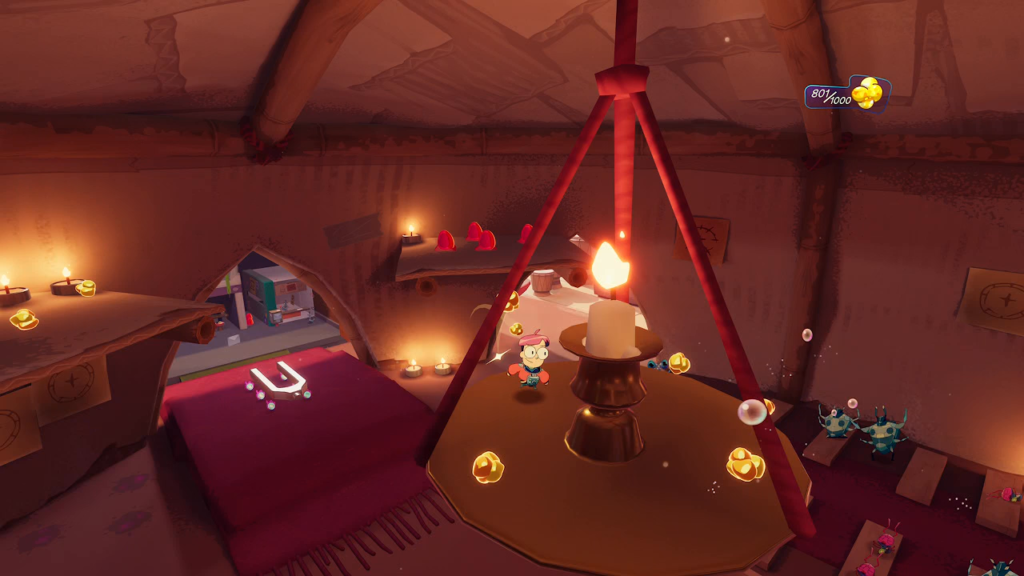
Tinykin is an all-around excellent 3D platformer, but where it is most successful is transforming something as mundane as a house into an interesting environment for platforming adventures. Its sheer scale carries most of that weight. Simple spaces like a living room and a bathroom become massive stadiums that comfortably host dozens of tiny characters and interesting objects to climb on and interact with. It’s the different bug cultures who reside in each room that embellish a plain world, filling every space with energy and activity.
The shield bugs have taken over the living room, building a cathedral in its center out of cardboard and votive candles. Inside, they worship Ardwin, the deity of all bugs whose music permeates every room in the house, though only the shield bugs can hear it. A bathroom sees the dung beetles and silverfish living as unhappy neighbors. The quiet beetles occupying the toilet go to destructive lengths to sabotage the silverfish’s all-night parties in the bathtub. On the second floor, a child’s bedroom has become an elaborate insect theme park. There a ferris wheel spins above a zoo filled with toy animals while insect spectators cheer on racers zooming around an electric stock car track.
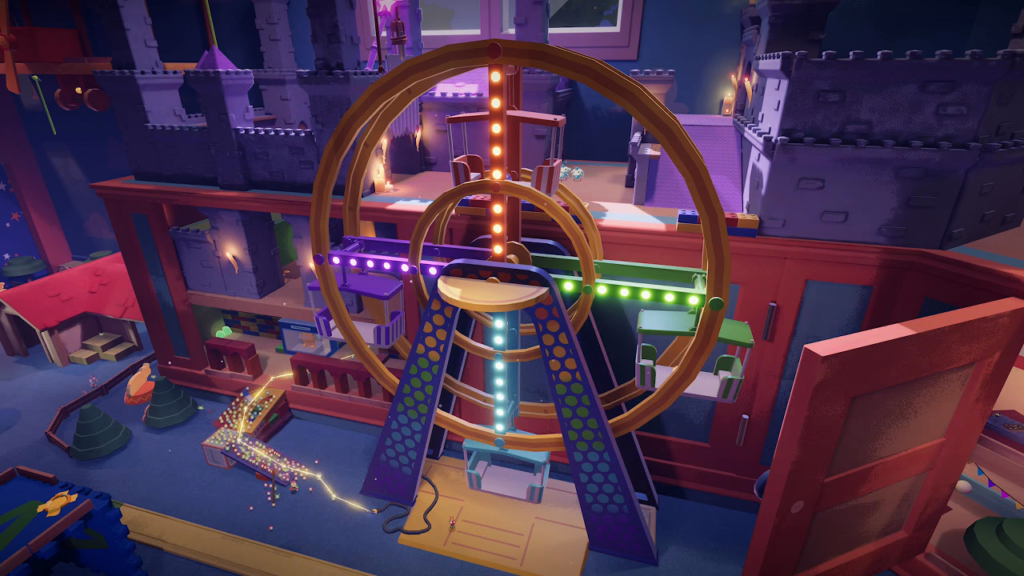
The house is such an effective setting because it distills nostalgic feelings of an early-1990s childhood before videogames and computers conquered the entertainment landscape. Toys and practical gadgets litter every room, each of them conceivably built by an imaginative child to service his tiny insect friends, but in truth constructed by the industrious and civilized insects themselves. It’s a playground in which Milodane is set loose to run, jump, and discover.
It is through these environments that Milodane goes on 3D platforming adventures. He has the familiar toolset of a 3D platforming player character to accomplish this task: He can run, and he can jump. When running is a little too slow, he can also use a soapboard—a literal bar of soap—to slide across the ground or grind along lines and edges at high speed.
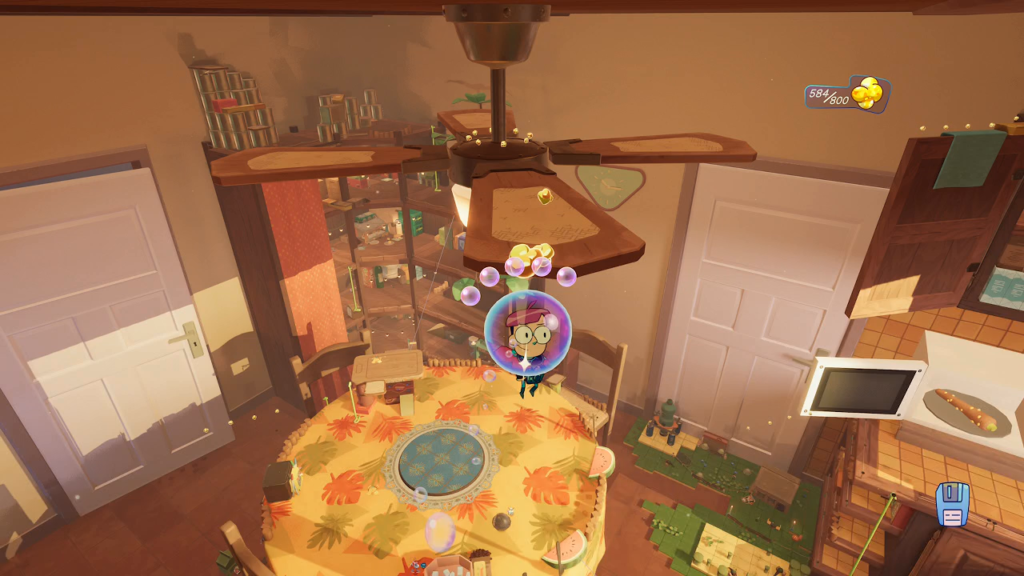
Milodane’s high-tech suit grants him his final, most powerful traversal ability. It generates a bubble that allows its wearer to float for a limited time. At first this has limited utility, useful only for crossing small gaps and ensuring that Milodane lands exactly where I want him to. As he explores each room, the power grows in strength thanks to an ant named Sikaru. By delivering pollen strewn across every room to Sikaru, the operational length of Milodane’s bubble grows. The sheer quantity of pollen strewn across every surface, around every corner, and under every nook creates a sensation of constant, tiny steps forward, marked by the expanding strength of Milodane’s bubbles.
Aside from the thousands of simple pollen collectibles, every room is also filled with other goals to accomplish. Each room’s main goals are clearly marked both in a menu and highlighted when Milodane puts on his AR goggles. Not highlighted, but by no means difficult to discover, are many optional goals. Lighting every candle in a room or delivering four letters to the local post office rewards Milodane with clusters of pollen. More unique goals, like helping some mantis scientists assemble a frog skeleton or retrieving the misfired ammunition for a balloon-popping carnival game, reward lost museum pieces that give hints to the fate of the house’s missing inhabitants and humanity in general.
There’s almost never a moment where I feel like I’m not progressing forward in some way thanks to Tinykin’s admirable levels of density. Every space is thick with activity that makes the house feel alive and my time rewarded.
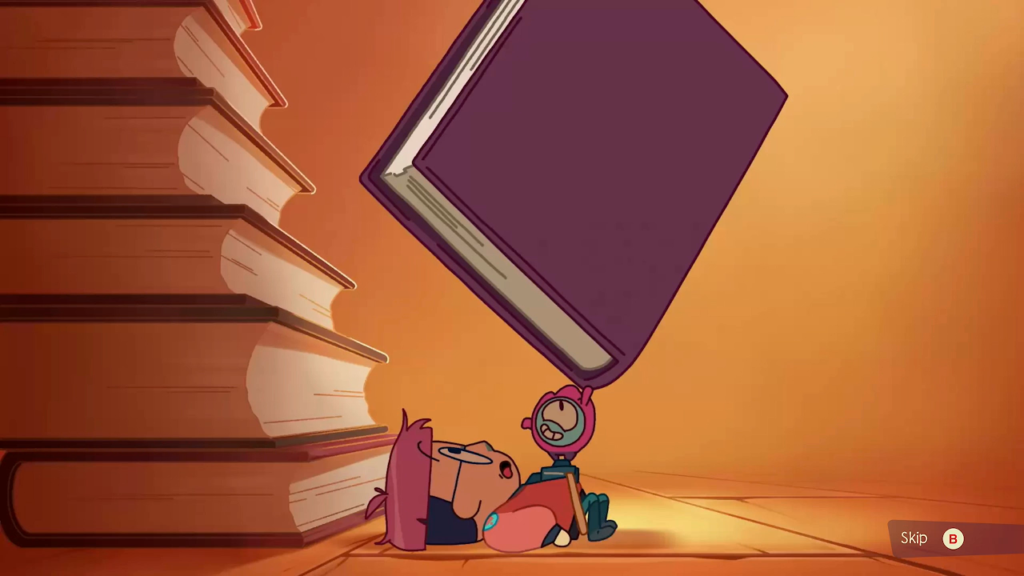
Milodane can navigate the house on foot mostly through his own power. In order to shape and change the environment to accomplish the house’s many goals, he requires the help of the Tinykin. He encounters them almost the moment he sets foot in the house, stumbling across their slimy cocoons whereupon they burst and swarm him. Despite the Tinykin’s alarming introduction, they are friendly and helpful creatures who immediately prove their worth on the adventure.
Tinykin come in five varieties. The first Milodane encounters are pink ones who possess strength disproportionate to their size, able to move objects many times larger than they are. Red ones explode when thrown against objects, lighting candles and knocking over fragile constructs. Green ones stack on top of each other, allowing Milodane to climb them like a ladder to previously-unreachable heights. There are two more varieties to discover whose abilities I want to leave a surprise for prospective players.
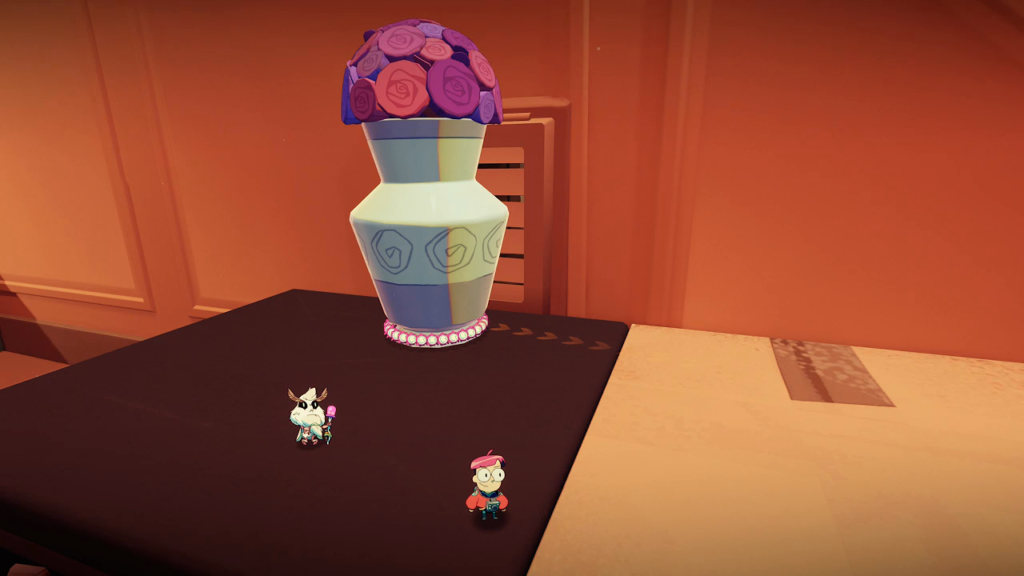
I cannot emphasize enough, no matter how much the preceding paragraphs may sound like it: Tinykin are not Pikmin. They are small, differentiated by color, and possess unique abilities, but the similarities end there. Milodane does not direct the Tinykin; they follow him loyally without the need to monitor their path. Tinykin do not need to be protected; they are immune to the house’s hazards, particularly water and fire, and only the red and blue ones expire when Milodane uses them to solve a puzzle. Tinykin do not reproduce; there is a finite number to be found in each room, placed in thoughtfully preset positions. Discovering all of them is one of the many platforming challenges to be accomplished in each room.
It’s much more useful to think of Tinykin as 3D platforming collectibles, resources which give Milodane access to new areas in each room. To destroy a matchstick box supporting a ramp, Milodane needs five red Tinykin. To reach the top of a shelf, he needs a dozen green ones. To move a polaroid camera into an entertainment center to take a vital photograph of a terrifying monster, he needs twenty-five pink ones. Since Tinykin do not leave the room where they are discovered, the problem they most often present is scrounging up enough to accomplish the next task between Milodane and a collectible.
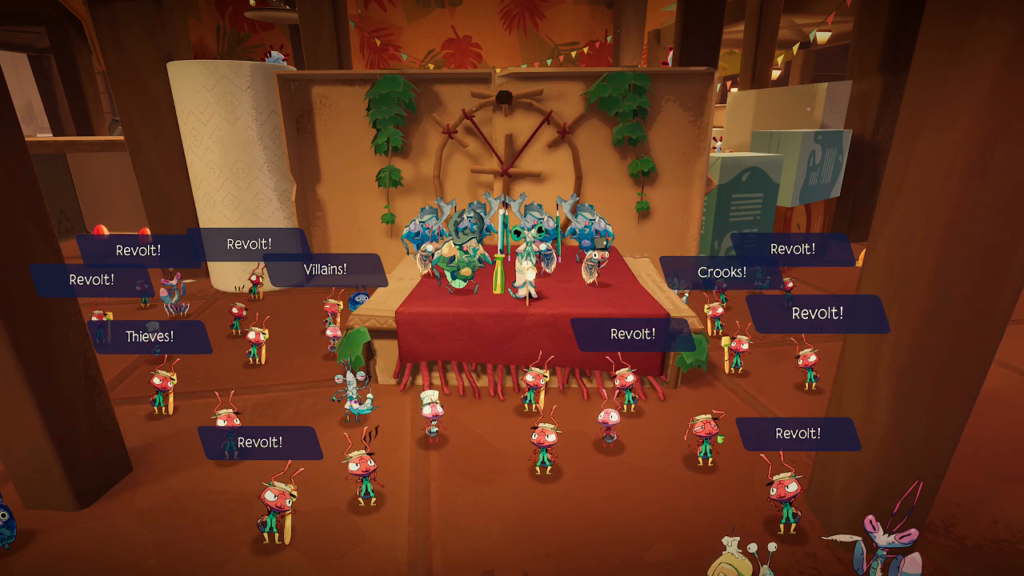
I commend Tinykin for its lack of violence. This is where it stands apart from Pikmin most visibly; there is no combat of any kind to be found in any of the house’s rooms. Though the different bug societies quarrel between each other, their coexistence is mostly peaceful. The worst that happens is a worker uprising against an aristocracy—in which Milodane’s role is uncomfortably close to that of scab and strikebreaker—yet even this conflict is waged non-violently by both parties. Tinykin is a pure adventure experience, the only hazards standing between its protagonist and his goals being natural ones like gravity and water.
Which isn’t to suggest that Tinykin is free of either tension or horror. The fun and friendly atmosphere is quashed by Milodane’s excruciating “death” when he touches water, his suit expanding and contorting while his large, expressive eyes widen in pain just before he pops like a bubble. He reappears with a flash where he was standing just before he fell as though nothing happened, but the memory of his painful demise lingers. There are also a few well-hidden spaces where music and lighting work together to create a creepy atmosphere that has me rushing to get Milodane out.
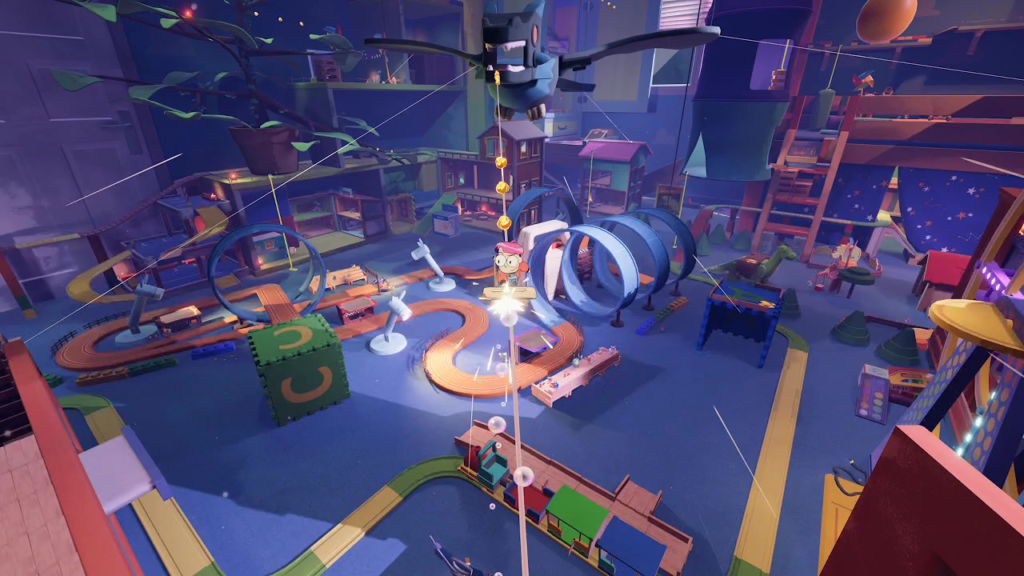
Tinykin is a wonderful 3D platformer, almost totally devoid of notable flaws. Milodane’s quest through the many rooms of the house does a marvelous job keeping me engaged, providing a pleasant drip feed of constant small rewards, interrupted only by occasional large reward injections that milestone his progress. Not once do I feel a drought, a bemused wondering on where I should go next, an aimless wandering to find one last lousy collectible to open the next door. It’s a flawlessly crafted experience that always effortlessly guides me to something useful and meaningful nearby. About the only criticism I may level against it is misrepresentation. It’s easy to presume Tinykin is a Pikmin clone, but in practice it is very little like one at all. It’s such an excellent 3D platformer that this false advertisement, which may only exist in my head, barely matters at all.